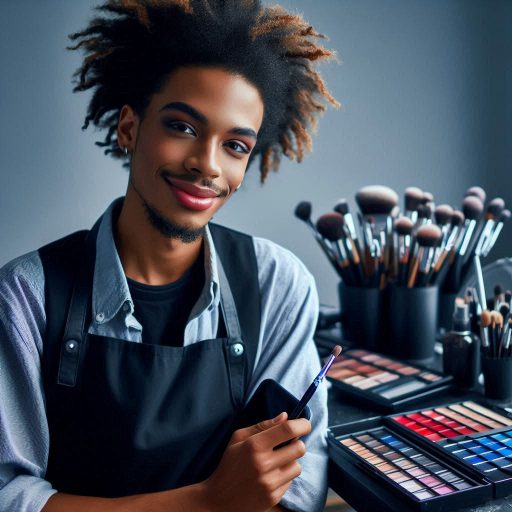Introduction
A multimedia artist blends various forms of media to create visual and interactive experiences.
They use digital tools to combine graphics, animation, video, and sound into cohesive projects.
Multimedia artists work across diverse fields, including film, video games, and online content.
Their role involves designing engaging visual elements that captivate audiences and convey messages effectively.
In today’s digital age, multimedia artists are crucial for several reasons.
They bring creativity and technical skills to a wide range of industries.
Their work enhances the user experience on websites, mobile apps, and social media platforms.
By creating dynamic visuals and interactive elements, they help brands stand out in a crowded market.
Multimedia artists also play a significant role in entertainment, from developing eye-catching video games to producing compelling film content.
The demand for multimedia artists is growing as technology evolves.
Businesses seek innovative ways to engage customers and tell their stories.
Multimedia artists help achieve this by using advanced software and techniques.
They stay ahead of trends to deliver cutting-edge content that resonates with audiences.
As technology continues to advance, multimedia artists will remain essential in shaping digital experiences.
In summary, multimedia artists blend art and technology to create engaging visual experiences.
Their work is increasingly important in a digital world that values creativity and innovation.
As technology and media continue to evolve, the role of multimedia artists will become even more integral to various industries.
Education and Training
The importance of formal education in multimedia arts
Formal education plays a crucial role in multimedia arts.
It provides a structured foundation in design principles, technology, and creative techniques.
A degree in multimedia arts or a related field offers a comprehensive understanding of visual storytelling and digital media.
Transform Your Career Today
Unlock a personalized career strategy that drives real results. Get tailored advice and a roadmap designed just for you.
Start NowInstitutions often cover essential topics like graphic design, animation, and interactive media.
Different degree programs or courses that aspiring multimedia artists can take
Several degree programs and courses cater to aspiring multimedia artists.
Bachelor’s degrees in Multimedia Arts, Graphic Design, or Animation offer a broad curriculum.
These programs typically include courses in digital imaging, video production, and 3D modeling.
Some universities also offer specialized degrees in Game Design or Web Development for niche interests.
The value of hands-on training and practical experience
Beyond formal education, hands-on training is invaluable.
Practical experience allows students to apply theoretical knowledge to real-world projects.
Internships and freelance work provide exposure to industry practices and client interactions.
Working on actual projects helps build a strong portfolio, showcasing skills to potential employers.
Workshops, online courses, and certification programs also offer practical training.
These options are often more flexible and can be tailored to specific interests.
They allow artists to stay updated with the latest software and techniques, adapting to industry changes.
Practical experience combined with formal education equips multimedia artists with a competitive edge in the job market.
In fact, both formal education and hands-on training are essential for success in multimedia arts.
Formal education provides a solid foundation, while practical experience enhances skills and creates opportunities.
Aspiring multimedia artists should pursue relevant degrees and seek practical experiences to thrive in this dynamic field.
Read: The Influence of Art History on Modern Makeup
Technical Skills
Essential technical skills required for multimedia artists (e.g., graphic design, video editing, animation)
Multimedia artists need a range of technical skills to thrive in their field.
Essential skills include graphic design, video editing, and animation.
Graphic design forms the foundation, requiring proficiency in tools like Adobe Photoshop and Illustrator.
Transform Your Career Today
Unlock a personalized career strategy that drives real results. Get tailored advice and a roadmap designed just for you.
Start NowMastering these tools enables artists to create visually compelling images and layouts.
Video editing is another crucial skill, involving software like Adobe Premiere Pro or Final Cut Pro.
This skill allows artists to craft engaging video content, from commercials to short films.
Animation skills, using programs like Adobe After Effects or Blender, are vital for bringing static images to life.
The importance of staying updated with the latest software and tools in the industry
Staying updated with the latest software and tools is equally important.
The multimedia industry evolves rapidly, with new tools and technologies emerging regularly.
Familiarity with the latest software ensures artists remain competitive and can leverage new features to enhance their work.
Regular updates and upgrades can significantly improve workflow efficiency and creative possibilities.
Artists who fail to keep up may find themselves at a disadvantage, struggling with outdated techniques and tools.
Resources for learning and improving technical skills
To learn and improve these technical skills, various resources are available.
Online courses from platforms like Udemy or Coursera offer comprehensive tutorials on graphic design, video editing, and animation.
Websites like Lynda.com and Skillshare provide access to industry professionals’ insights and techniques.
Additionally, participating in forums and online communities, such as Behance or Dribbble, allows artists to exchange knowledge and seek feedback.
Regularly practicing and experimenting with new tools also helps in skill enhancement.
By leveraging these resources, multimedia artists can stay ahead in a competitive industry and continuously refine their technical expertise.
Read: Innovative Makeup Techniques and Trends
Creativity and Innovation
The role of creativity in multimedia arts
Creativity drives the multimedia arts, transforming ideas into captivating visuals, animations, and interactive experiences.
It is the core of multimedia artistry, enabling artists to express unique perspectives and craft compelling narratives.
Without creativity, multimedia art risks becoming formulaic and uninspired.
Therefore, embracing creativity is essential for producing work that stands out in a crowded field.
Transform Your Career Today
Unlock a personalized career strategy that drives real results. Get tailored advice and a roadmap designed just for you.
Start NowHow multimedia artists can stay innovative and original in their work
To remain innovative and original, multimedia artists must continually seek new sources of inspiration.
Experimenting with various techniques, tools, and styles can lead to breakthroughs.
Engaging with other artists, attending industry events, and exploring different art forms can also spark new ideas.
Staying abreast of emerging trends and technologies allows artists to incorporate fresh elements into their work, keeping their creations relevant and exciting.
Tips on how to nurture creativity and think outside the box
Nurturing creativity requires intentional practices.
Regular brainstorming sessions can help generate new ideas and approaches.
Setting aside dedicated time for exploration and experimentation encourages artistic growth.
Artists should also challenge themselves with projects outside their comfort zones to develop versatility.
Embracing failure as a learning opportunity rather than a setback fosters resilience and innovation.
Thinking outside the box involves looking beyond conventional solutions.
Artists can break away from traditional methods by reimagining familiar concepts and combining disparate elements.
Encouraging diverse perspectives and collaborating with individuals from different disciplines can provide new insights and approaches.
Incorporating feedback from peers and audiences can also refine and expand creative strategies.
In summary, creativity and innovation are crucial for multimedia artists seeking to make an impact.
By embracing a proactive approach to inspiration and experimentation, artists can cultivate their creativity and produce original, compelling work.
Read: How to Keep Up with SFX Industry Trends

Communication Skills
The importance of effective communication for multimedia artists
Effective communication is crucial for multimedia artists.
It ensures clarity and understanding between artists, clients, and collaborators.
Clear communication helps to convey ideas, expectations, and project goals accurately, which is essential for successful project execution.
How multimedia artists collaborate with clients, team members, and other professionals
Multimedia artists often work with clients, team members, and other professionals.
Transform Your Career Today
Unlock a personalized career strategy that drives real results. Get tailored advice and a roadmap designed just for you.
Start NowThey must articulate their vision and understand others’ input.
Collaborating with clients involves discussing their needs and providing updates on progress.
Working with team members requires sharing ideas and feedback, while interaction with other professionals may include coordinating technical requirements or artistic direction.
Effective communication helps to align everyone’s goals and maintain project momentum.
Tips on how to improve communication skills in a multimedia art career
To improve communication skills in a multimedia art career, consider the following tips:
- Practice Active Listening: Pay close attention to what others are saying.
Confirm understanding by summarizing key points and asking clarifying questions. - Be Clear and Concise: Articulate your ideas simply and directly.
Avoid jargon unless everyone involved is familiar with the terms. - Develop Presentation Skills: Present your work and ideas confidently.
Use visuals to enhance your explanations and make your points clearer. - Seek Feedback: Regularly ask for feedback on your communication.
Use it to refine your approach and improve your effectiveness. - Enhance Writing Skills: Strong written communication is essential for creating clear briefs, emails, and project documentation.
Practice writing and editing to improve clarity. - Build Rapport: Establish good relationships with clients and colleagues.
Being approachable and respectful fosters a positive working environment and facilitates smoother communication.
By honing these skills, multimedia artists can better navigate their professional landscape, ensuring successful collaborations and satisfying project outcomes.
Effective communication is a cornerstone of a thriving multimedia art career.
Read: Understanding the Art and Design of Makeup
Time Management and Organization
The fast-paced nature of multimedia art projects
In the fast-paced world of multimedia art, time management and organization are crucial.
Multimedia projects often involve tight deadlines and complex workflows.
Artists juggle various tasks, from conceptualizing designs to finalizing animations.
Efficient time management ensures that artists meet deadlines without compromising quality.
Strategies for managing time efficiently and meeting deadlines
Start by breaking projects into manageable tasks.
Create a detailed plan with milestones and deadlines.
Use tools like Gantt charts or project management software to track progress.
Prioritize tasks based on their importance and deadlines.
This approach helps in maintaining focus and avoiding last-minute rushes.
Adopt the Pomodoro Technique to boost productivity.
Work in focused intervals, followed by short breaks.
This method enhances concentration and reduces burnout.
Transform Your Career Today
Unlock a personalized career strategy that drives real results. Get tailored advice and a roadmap designed just for you.
Start NowSet specific goals for each work session, and review your progress regularly.
This strategy helps in staying on track and adjusting plans as needed.
The importance of organization in keeping track of projects and assets
Organization plays a key role in managing multimedia art projects.
Maintain a well-structured file system for all assets.
Use clear, consistent naming conventions for files and folders.
Organize your workspace to minimize distractions and streamline your workflow.
Regularly back up your work to prevent data loss.
Implement a digital asset management system to catalog and retrieve files efficiently.
This system helps in quickly locating assets and tracking revisions.
Keep detailed records of project versions and changes.
This practice avoids confusion and ensures that you can revert to previous versions if needed.
By mastering time management and organization, multimedia artists can navigate the demanding nature of their work effectively.
These skills not only improve productivity but also contribute to a more manageable and less stressful work environment.
Embrace these strategies to enhance your efficiency and success in the multimedia arts.
Adaptability and Flexibility
The ever-changing landscape of multimedia arts
The multimedia arts landscape evolves rapidly, requiring artists to stay agile.
New technologies, trends, and platforms emerge frequently, shaping the industry’s direction.
This constant change means multimedia artists must embrace adaptability and flexibility to remain relevant and successful.
Adapting to new technologies is crucial.
The tools and software used in multimedia arts continually advance, presenting both challenges and opportunities.
For instance, virtual reality and augmented reality have transformed how artists create and present their work.
Transform Your Career Today
Unlock a personalized career strategy that drives real results. Get tailored advice and a roadmap designed just for you.
Start NowKeeping up with these innovations ensures artists can leverage the latest techniques and maintain a competitive edge.
The need for multimedia artists to adapt to new technologies and trends
Trends in multimedia arts also shift swiftly.
What’s popular today may be outdated tomorrow.
Artists need to be aware of current trends and how they impact their work.
By staying informed, artists can incorporate fresh ideas and techniques into their projects, making their work more engaging and contemporary.
Tips on how to stay flexible and versatile in a multimedia art career
To stay flexible and versatile, multimedia artists should cultivate a mindset of continuous learning.
Engage in regular training and professional development to master new tools and techniques.
Online courses, workshops, and industry conferences offer valuable learning opportunities and networking.
Additionally, experimenting with various styles and mediums can broaden an artist’s skill set and adaptability.
Networking with other professionals in the field is also beneficial.
Building relationships with peers can provide insights into emerging trends and new technologies.
Sharing knowledge and experiences with others helps artists stay updated and adaptable.
All in all, adaptability and flexibility are essential for success in multimedia arts.
Embracing new technologies, staying aware of trends, and committing to ongoing learning will keep artists relevant and innovative in an ever-evolving industry.
Networking and Professional Development
The importance of building a strong network in the multimedia arts industry
In the multimedia arts industry, building a strong network is crucial.
Networking opens doors to opportunities and collaborations that might otherwise be inaccessible.
Relationships with other artists, clients, and industry professionals can lead to valuable partnerships and projects.
Strong connections often lead to job referrals and mentorship opportunities.
The benefits of attending conferences, workshops, and networking events
Attending conferences, workshops, and networking events offers numerous benefits.
These events provide a platform to meet industry leaders and peers, share ideas, and gain insights.
Transform Your Career Today
Unlock a personalized career strategy that drives real results. Get tailored advice and a roadmap designed just for you.
Start NowWorkshops often offer hands-on experience and exposure to new techniques and tools.
Conferences present opportunities to hear from experts, learn about industry trends, and engage in discussions that can inspire and inform your work.
Tips on how to grow professionally and advance in a multimedia art career
To grow professionally and advance in your multimedia art career, focus on continuous learning and skill development.
Keep up with industry trends and technologies to stay relevant.
Participate in online forums and join professional organizations to connect with others in your field.
Seek out mentorship from experienced professionals who can offer guidance and support.
Additionally, create and maintain an online portfolio showcasing your best work.
A strong portfolio not only highlights your skills but also attracts potential clients and employers.
Regularly update your portfolio to reflect your latest projects and achievements.
Finally, set career goals and regularly review your progress.
Attending networking events and professional development opportunities can help you stay motivated and focused.
By actively engaging with the multimedia arts community, you position yourself for growth and success in this dynamic field.
Conclusion
To become a successful multimedia artist, you need to have a combination of technical skills, creativity, and a strong work ethic.
These essential skills include proficiency in graphic design, video editing, animation, and audio production.
Additionally, having a good eye for aesthetics, attention to detail, and the ability to work well under pressure are crucial for success in this field.
Aspiring multimedia artists should continue to develop their skills through practice, taking on projects that challenge and push their limits.
It is essential to stay updated on the latest trends and technologies in multimedia art to remain competitive in the industry.
Pursuing internships or freelance opportunities can also provide valuable real-world experience and help build a strong portfolio.
Ultimately, success as a multimedia artist requires dedication, passion, and a willingness to continually learn and grow in your craft.
By honing your skills, staying creative, and staying committed to your artistic vision, you can carve out a fulfilling career in the dynamic and ever-evolving world of multimedia art.
Transform Your Career Today
Unlock a personalized career strategy that drives real results. Get tailored advice and a roadmap designed just for you.
Start Now[E-Books for Sale]
The Big Book of 500 High-Paying Jobs in America: Unlock Your Earning Potential
$19.99 • 500 High-Paying Jobs • 330 pages
Explore 500 high-paying jobs in America and learn how to boost your career, earn more, and achieve success!
See All 500 High-Paying Jobs of this E-Book
1001 Professions Without a Degree: High-Paying American Jobs You Can Start Now
$19.99 • 1001 Professions Without a Degree • 174 pages
Discover 1001 high-paying jobs without a degree! Unlock career tips, skills, and success strategies for just $19.99!




